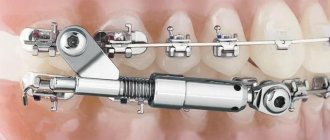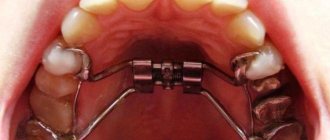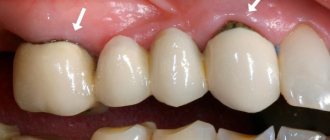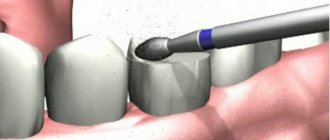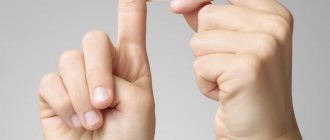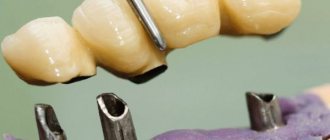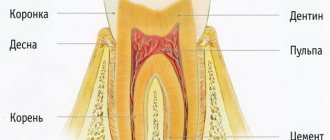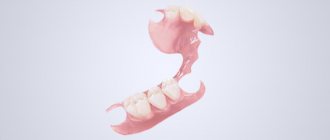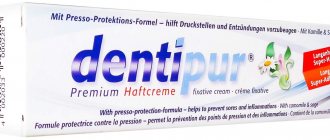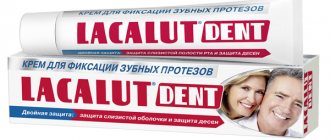More than 10 years ago, it was customary to correct the bite starting from adolescence. Dentists have proven that this is wrong.
Today, orthodontists have developed a technique that can prevent the development of anomalies, starting from early childhood. This saves not only money, but also time. After all, it is better to take preventive measures in childhood than to wear braces in adulthood.
The Haas apparatus can cope with this task. Dentists consider this device unique, and for good reason.
General information
The Nord appliance, also known as the Derichsweiler appliance, is a mechanically operated fixed orthodontic appliance designed for rapid or slow expansion of the upper jaw.
The device consists of the following elements:
- Hyrax screw , which creates expansion force;
- two or four metal rings placed on the supporting teeth, the role of which is played by the second molars and premolars;
- two (left and right) beams soldered to the rings on the palatal side and, in addition to them, transmitting pressure to the chewing teeth and canines. two (left and right) acrylic plates connecting the screw to the rings.
Jaw expansion is carried out by daily single or double activation of the screw by ½ or ¾ turn. Tightening is done using a special tool with a pin that is inserted into the holes on the screw head.
Keys are available in various designs - with or without backlight, with or without a rotation angle control mechanism.
Under the influence of the force created by the screw, the median palatal suture increases, providing a gradual expansion of the jaw by an average of 6-9 mm. Typically, the active correction phase does not exceed 4-5 weeks, followed by a retention period lasting up to six months.
Nord devices are often used in combination with other orthodontic devices , in particular braces. They can be additionally equipped with elements that make such work possible.
In particular, buccal tubes can be soldered to the rings to install a vestibular arch, hooks and levers for elastomeric or spring ligatures can be attached, and torque devices can be installed.
Types of preventive orthodontic devices and features of devices.
Come here to take a closer look at powered orthodontic appliances.
At this address, read about the indications for using the Schwartz apparatus in orthodontics.
What does it represent?
In orthodontics, this is the name for a structure that refers to the type of palatal clasp . It is not removable, but is worn throughout the entire period of teeth straightening.
The Nance apparatus is installed only on the upper jaw .
Design
This orthodontic device consists of a metal arch with bandage rings covering problem teeth on both sides. The design also includes a plastic button, which is located in the middle and is adjacent to the sky.
Without it, the device will not be useful for straightening teeth, since it acts as a stop and serves to secure the metal elements in the mouth .
The button is necessary so that the structure can apply maximum pressure on the teeth, keeping them in a certain position for a long time.
Principle of operation
The structure is fixed on the unevenly growing teeth of the upper jaw. The leveling speed of this device averages 1.9 mm over the course of a month .
At the ends of the device there are rings that are attached to the molars. The button rests on the convexity of the hard palate, slightly short of the gingival margin. This distance is 0.5 - 1.5 cm.
Because of this design, the device is sometimes called the Nance button .
Indications for use
The Nord design is indicated for use when the jaw is narrowed by at least 4 mm. The optimal age for use is late mixed and early permanent dentition. During this period, the success rate of treatment is almost 100%.
The device can also be used in adults with an ossified palatal suture. During the treatment process, it ruptures, expands and subsequently fusions during the retention period.
The main clinical situations in which the Nord system is used:
- Symmetrical crossbite.
- Shortening of the upper dentition.
- Tight or crowded position of the front teeth.
- Medial position of premolars and molars.
- Surgical pathologies of the third class.
- Breathing problems caused by reduced volume of the nasal cavity due to narrowing of the jaw.
There are cases in which the Nord device is contraindicated. These include:
- asymmetrical crossbite (in this case, unilateral jaw expansion is required);
- weak periodontium.
When using the system during the early mixed dentition, caution is required due to the weakness of the primary teeth used as abutments. In this case, it is desirable to use other devices that provide force distribution in a way that is safer for primary teeth.
In particular, the structures are equipped with acrylic plates that transmit force to the mucous membrane of the alveolar process.
Arc Lurie
Helps correct abnormal occlusion of the upper teeth.
general characteristics
The Luri apparatus is presented in the form of a universal complex structure, which has a labial arch as its basis. Belongs to non-removable type devices. Used when gentle correction is needed.
The product consists of the following elements: the main labial arch, finger-like processes with a springing effect. The arch is made on the basis of its complete repetition of the dentition.
It is secured using two metal crowns or rings attached to the molars. Each crown has one metal sleeve necessary to secure the archwire.
Operating principle
The corrective effect is carried out through constant pressure exerted by springy appendages. They have shape memory, as a result of which they try to return to a given position, thereby exerting constant pressure on the teeth and causing a change in their position.
Since each process has little mechanical force, correction requires a fairly long period of time.
Indications and contraindications
The use of a Luri corrector is justified in the presence of protrusive inclination of the upper dentition. It can be used to correct misaligned teeth by moving them distally.
Also, an orthodontic arch helps to give the correct position to single front teeth.
Preparatory stage
The manufacturing process includes the following steps:
- Preliminary taking of impressions from the upper and lower jaws.
- Preparation of a working plaster model.
- Manufacturing of supporting elements - metal crowns or rings for molars. Soldering bushings.
- Carrying out fittings and taking repeated impressions.
- Making an arc. The material used is wire for orthodontic appliances.
- Soldering ligature hooks, if necessary.
To use the Luri arc, constant activation is required, at least once every 7 days.
Therapy process
The duration of treatment depends on the degree of complexity of the pathology and the type of malocclusion. The presence of minor deviations in the location of the teeth and the initial period of formation requires a course of treatment within 4-6 months. If the development of the pathology is at a late stage, then correction can last approximately 1 year.
Advantages and disadvantages
The arch is aesthetically pleasing to wear, has a gentle effect with no pain during the correction period, and has a compact design that facilitates quick adaptation to the device.
Among the disadvantages are:
- duration of the therapeutic period;
- limited possibilities, suggesting the correction of only minor deviations in the position of the teeth.
The Lurie arc is quite effective when it is necessary to correct abnormal occlusion of the upper teeth, however, it is currently rarely used due to the listed disadvantages.
Device cost
The price at which the Luri device is manufactured is on average 5,500 rubles. However, the cost of treatment is much higher, since it involves preparing teeth, correction and monitoring the progress of the treatment process.
I recommend the Luri apparatus for use. I would like to note that it does not cause discomfort, and adaptation occurs quite quickly.
Orthodontist
Operating principle
The operation of the Nord system is based on the creation of an expanding force by the Hyrax screw and its transmission to the palatal surface of the chewing teeth through rings and acrylic plates. Under its action, the palatine bone expands along the line of the median suture.
It ruptures if it has already fused, or expansion occurs without rupture if obliteration of the suture has not yet occurred. The device is activated by turning a screw with a special key by the patient himself or another person.
There are fast and slow expansion technologies. With fast, the screw is tightened once or twice a day by ½ or ¾ of a turn, which is 0.2-0.5 mm. With slow expansion, the screw is activated once every 3 days. The most commonly used is rapid expansion.
The active phase of treatment is followed by a retention period, ensuring the absence of relapse and the fusion of the palate bones in the new position.
The essence of the use of the Alf system in orthodontics and the effectiveness of the device.
In this publication we will talk about the purpose and types of bionators.
Here we will consider the technique of using the Persin apparatus to correct mesial occlusion.
Ainsworth's device
Mechanical orthodontic device.
general characteristics
It is a non-removable arc device. The design includes rings or crowns, a tangent wire, vertical tubes that perform a supporting function, and a spring arch.
Operating principle
The main role in this device is given to the arc. It is bent in such a way as to follow the line of the dentition.
The action of the design is based on the tendency of the arch to its original shape, as a result of which all the teeth attached to the components of the device shift behind it. The strength is adjusted by a doctor.
Indications for installation
"Ainsworth" has versatility in application and can be used to solve most problems associated with bite.
Manufacturing and fastening process
The manufacturing procedure is based on a number of steps:
- preparing a plaster cast of the jaw;
- making a plaster model, tubes and wire;
- fitting, finishing and connecting elements, their installation on a plaster model;
- arc manufacturing;
- installation of the finished structure.
Before installing the device, you need to remove plaque and tartar.
Therapy process
For treatment to be effective, you must follow all the requirements and recommendations of the doctor.
The duration of the adaptation period ranges from 1 week to 1 month. At this time, it is important not to eat foods that contribute to painful sensations, to carefully care for the oral cavity, to use soothing and disinfecting decoctions, painkillers prescribed by a doctor.
In addition, you need to be monitored by a doctor approximately once a week.
Advantages and disadvantages
The Ainsworth arc is characterized by reliability, individual model for each patient, guaranteed results, constant medical supervision, and variability of action.
The disadvantages of using it are that the device is quite noticeable, requires a long time to get used to, complex care, a long preparation process, and the possibility of a doctor making a mistake cannot be ruled out.
Quite effective in correcting most dental pathologies. Has precise impact.
Treatment price
The cost of installation, services for weekly monitoring and subsequent removal averages from 10 to 15 thousand rubles.
Advantages and disadvantages
Expansion of the jaw using the Nord apparatus and similar orthodontic devices is a classic method of treating narrowing of the upper jaw, firmly established in the practice of orthodontists around the world. The device has the following advantages:
- High predictability and effectiveness of treatment , reaching one hundred percent results in some periods.
- Achieve rapid success with rapid expansion. A treatment time of just 4-5 weeks is considered very fast in orthodontics.
- Accompanying the expansion is an increase in the length of the dental arch , leading to a decrease in space deficit. According to research, jaw expansion by 1 mm leads to an increase in arch length by 0.7 mm.
- Compatible with other orthodontic appliances.
- Solving breathing problems (expanding the airways).
- Normalization of facial proportions and improvement of smile aesthetics.
There are also negative aspects in using the Nord system, which create the need, if not abandonment, then at least caution and accuracy.
These include the following factors:
- The possibility of a negative impact on the rudiments of permanent teeth in cases where the function of supports is performed by milk teeth.
- Great force required to open the palatal suture. It can reach 1.4-4.5 kg, which is dangerous due to too high compression in the periodontium, impaired blood microcirculation and tissue necrosis.
- There is a risk of the supporting teeth moving upward, which can lead to an open bite.
- The need in some cases to resort to hyperexpansion to compensate for a possible relapse.
- Duration of the retention period in comparison with the treatment course.
Manufacturing
The manufacture of the Nord apparatus requires taking impressions and molding plaster models based on them. Impressions are required to make rings on the supporting teeth and assemble the entire structure into a single whole outside the oral cavity.
In general, the device manufacturing technology consists of the following steps:
- Taking impressions from the jaws.
- Casting plaster models.
- Manufacturing according to models by stamping or casting rings on abutment teeth.
- Fitting the rings onto the teeth, modifying them if necessary.
- Installing the rings and screw mechanism on the model, pouring acrylic plasticine (connecting the screw mechanism and rings into a single structure).
- Trying the model on the teeth, finalization, final installation of the structure.
Watch the video to see how the structure is made.
General overview
The Haas appliance belongs to the category of fixed mechanical orthodontic devices designed to move teeth in certain directions and expand the child’s jaw rows.
It consists of the following structural elements:
- metal frame made of medical steel, eliminating the development of an allergic reaction;
- plastic plates that help increase the support area on the palatal surface;
- Hyrex expansion screw , which allows you to adjust the size of the device during treatment;
- rings and clasps used to fix the device on the patient’s teeth.
The Haas device is used during primary dentition to expand the palatal plane and create additional space for the eruption of permanent elements of the row.
It is fixed using fasteners on the primary canines and second molars of the upper jaw row.
The device is manufactured individually for each patient, taking into account his clinical situation, after a preliminary examination of the oral cavity and taking an impression. Composite materials or dental cement are used to fix the device.
Fixation process
The device is fixed in the oral cavity by installing rings on the supporting teeth using temporary cement. Activation is performed with a special key.
The head of the screw has holes into which the key pin is inserted. For convenience and simplification of the procedure, keys of an improved design can be used - with backlighting and a mechanism that eliminates under-turning of the key, as a result of which the next hole is in an area inaccessible to the key.
The activation operation itself is painless, but after it there is an unpleasant feeling of pressure on the teeth. Similar discomfort is present when using almost any orthodontic device.
You just need to endure it for a few hours and it will begin to weaken. As a last resort, you can take painkillers.
Other side effects of installing the Nord apparatus may include impaired diction and increased salivation (salivation). They also disappear over time.
As already noted, the average treatment time is about a month. But to consolidate the treatment result and ossify the palatal suture, the device must be worn for about another 5-6 months without activation.
Installation
First, a plastic plate is tried on; it should be located inside the palate, from the edge of the second premolars to the middle of the canines.
The appliance is then polished and the rings are attached to the teeth using dental cement. The frame is carefully adjusted to the shape of the row so as not to irritate the lips from the inside. Then the spring and hook are installed.
Half a centimeter at the end of the frame needs to be bent into a loop (pre-heating), set at the level of the middle of the fang. When attaching a ligature to the teeth, the doctor should not cut the end of the wire
.
Then the metal part of the device is tightened to evenly distribute the pressure on the teeth.
Price issue
The cost of bite correction using the Nord system is about 25,000 rubles. This amount includes the price of the device itself (10-15 thousand) and the cost of treatment, including consultation, diagnosis, drawing up a treatment plan, installation and activation of the device, monitoring the correction process.
In some special cases, depending on the individual clinical picture, modification of the design may be required. In particular, equipping it with buccal tubes, additional hooks and supports for spring and elastic ligatures.
In such cases, for obvious reasons, the price of the system, and, consequently, the total cost of treatment, can increase to 30 thousand or more rubles.
But this money will not be wasted, since the positive effects of jaw expansion are significant and multifaceted. This is correction of the bite and normalization of the functioning of the entire dentofacial apparatus, improvement of facial aesthetics, correction of breathing problems, and, as a result, a general improvement in health.
Reviews
Maxillary expansion is a fairly large-scale orthodontic procedure with significant health benefits.
If you have personal experience of this type, tell us how successful it was for you or your child. What moments of treatment were the most memorable? The feedback form is located at the bottom of this page.
If you find an error, please select a piece of text and press Ctrl+Enter.
Tags: bite correction plates
Did you like the article? stay tuned
No comments yet
